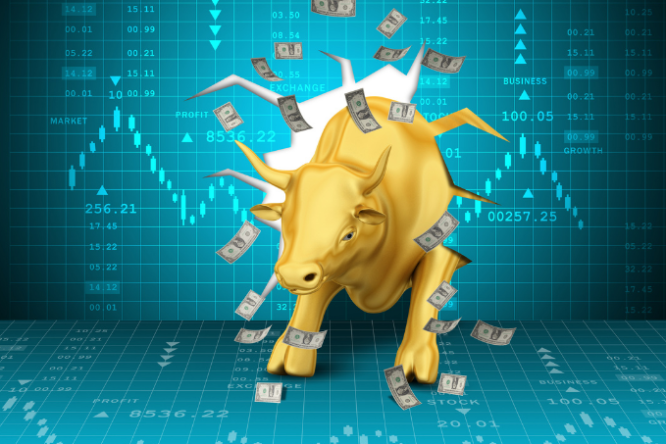What is Bull Market and How can Investors Benefit from one?
Stock Market Basics
A bull market is a condition of a market where prices keep rising or are anticipated to rise continually. Usually in this kind of market there are more buyers than sellers in this kind of market phase .It is a time when an asset or security's price is constantly rising. It is often defined as a 20% increase in stock prices.
Investors have great expectations for the performance of the stock market during this time and readily allocate their funds to this industry. A rising degree of customer confidence allows businesses to grow, which raises earnings that may be distributed to shareholders and thus increases the cash flow into this industry.
Analyzing the Bull market
Bull market peaks are typically better analyzed using averages, such as stock indices like the Sensex or Nifty. Many lessons can be learned by seeing bull market peaks during the previous century. In bull markets, top formation is typically a gradual process. The market climbs higher for three or four large segments or phases before losing momentum and beginning a protracted decline. The market's internal breath has already begun to fade by the time trade volumes reach their peak. It appears like a bear market is about to begin.
Investing tips for a bull market
When making an investment in a bull market, there are a few things to think about. Although every investor has a different approach, there are a few common things that investors typically do in bull markets.
Give dividend-paying stocks priority. Publicly listed corporations that distribute dividends to their shareholders from their profits offer dividend stocks. Prosperous corporations with a track record of raising dividends are more likely to distribute profits to shareholders during a bull market. You can use dividends as a reliable source of revenue or reinvest them in the business.
Investors have great expectations for the performance of the stock market during this time and readily allocate their funds to this industry. A rising degree of customer confidence allows businesses to grow annual turnover, which raises earnings that may be distributed to shareholders and, in turn, increases the cash flow into this industry.
How does a Bull market happen?
It can be difficult to recognise a bullish market. A bull market is common in nations with essentially sound policies in place, a well-executed implementation regime to guarantee sufficient production of products and services, and favourable market circumstances to support sales. Rising benchmark index points are primarily indicative of bullish markets, since large-cap firms show notable long-term advancement. Reductions in interest rates and large tax rates are examples of expansionary demand-side policies that typically trigger long-term bull cycles in the stock market. Increased speculative demand drives up stock prices because greater income levels brought about by these expansionary policies ensure that there is sufficient money available for stock market investments. Since price changes are more substantial during a positive market trend, a growing volatility index is a key predictor of a bull market. The business cycle includes a bull market trend and growing GDP rates that signal an economy's productive capacity, and growth rates are significantly higher during the boom phase.
Some attributes of the bull market
A bull market often emerges from a period of declining stock prices, followed by a rise of more than 20% in the same securities. Since more investors are eager to purchase and hold stocks in order to realise financial gains, there is also more trading activity during bull markets.
In a bull market, the value of securities increases, and many investors are ready to pay more for them in the hope that the market will continue to rise. Investors who have been holding onto specific stocks and bonds may even think about making a calculated transaction or selling them while the prices are high.
How does the Bull market affect the economy?
A positive market trend raises economic growth, which in turn may raise the demand for products and services. Inflation may result from this increased demand, pushing prices higher. As share prices rise, investors see a growth in assets, which could lead to increased consumer confidence and expenditure. This can hasten economic growth because it boosts investor confidence and willingness to spend discretionary funds.
In a Bull market, what actions should investors take?
When reselling their acquired assets, investors in small and mid-cap firms have strong returns, while those who choose to construct their portfolio through large-cap corporations benefit from regular dividend payments. Investors benefit in the long run since they can choose to sell their securities at the top of the business cycle.
Bullish markets enable all operating businesses to prosper for a considerable amount of time, as demonstrated by higher profitability and top-line revenue, which in turn raises stock values. Due to these businesses' strong growth, investors can benefit from their individual investments through capital gains and on-time payouts.
In the bull market, the buy-and-hold approach works best since investors who choose to hang onto their stocks will almost certainly realise dividend payouts. Furthermore, investors will only be able to realise sizable capital gains if they decide to hold onto their shares until values climb considerably.
Investors that are familiar with how the stock market operates frequently adopt an increased "buy and hold" strategy, continuing to buy securities as long as the rising trend in stock prices persists. This raises the total capital gains that are realised after the market recovers from the market correction and raises the price of stocks. It is a golden chance for novices to begin investing in the stock market because the likelihood of suffering significant losses is low.
In a bull market, companies can find it simpler to raise money through share offerings. This may promote investment in new projects and business expansion, both of which may accelerate economic growth, which may lead foreign investors to invest.
Therefore, a stronger national currency may result from this and capital inflows. Investors typically have faith in the strength of the stock market and its potential for future gains during a bull market. In a bull market, investors typically buy more stock and hang onto their investments. A bull market is typically followed by a robust economy characterised by high employment rates and expanding GDP, as well as favorable outcomes in other important economic.


